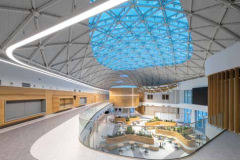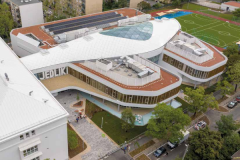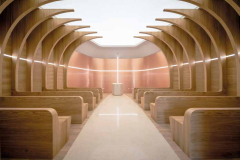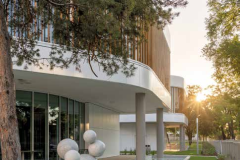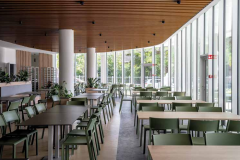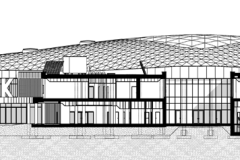Everyday Parametricism
Ányos Jedlik High School, Budapest
Architecture: RMG Atelier, bim.Group
Text: Bálint Botzheim
Photos: György Palkó
Not far from the centre of Csepel, in the heart of the residential area, stands another example of Hungarian parametric architecture, the newly renovated Ányos Jedlik High School. The old building and the newly completed extension, which is a legacy of the social-realist period, blend in with its surroundings without ostentation, fulfilling its role in a literally everyday way, whilst incorporating the highest-standard contemporary design methods regarding both desing and construction. The original school was built in 1952 and renovation and extension were long overdue, both because of the condition of the building and because of its limited capacity in relation to the growing number of students. The new building complex has an airy appearance, but also responds sensitively to its surroundings. The lobby is marked by a roof that floats fluidly outwards from the old block, and also reflects the fluid spatiality of the building. The characteristic volume of the chapel, which seems to float in space, marks a focal point of the structure. The spatial organisation of the building is also well conceived in terms of community building, with communication areas and seating zones at every step providing space for informal meetings.
General planning: bim.Group
Leading architects: Ádám Szabó, Zoltán Porcsalmy
Architects: Eszter Formanek, Richárd Hegedűs, Ádám Kovács, András Jancsa, Attila Makkai, Dávid Mári
Fellow architects: Áron Bíró, Gábor Toldy DLA
Concept: Zoltán Reznicsek, Anett Mizsei, Levente Gyulai – RMG Atelier
Structure: Gergely Sipos
Glass structures: Márton Kucsera
Framework: Lajos Zeleny, János Szűcs, Anikó Mező Nagy, Arnold Gyuricza, Eszter Varga-Arent, Róbert Fekete
Leading interior designer: Eszter Tusán, Zoltán Reznicsek
Fellow interior designers: Virág Dunai, Soma Jávor, Tamás Ferenc Molnár, Alex Váradi, Lilla Opauszki
HVAC: Orsolya Récsey, András Bujk, József Mihály Balogh
Electrical engineering: Gábor Balán, Richárd Bartha, Csaba Stummer
Weak power: Balázs Káplár
Fire protection: Levente Szőllősi
Plans before construction phase: Bendegúz Csuba, Attila Botond Juhász
Traffic: Zoltán Ország, Norbert Varga
Plans before construction phase: Zsolt Gutléber
Environment: Dániel Takács PhD
Kitchen technology: Árpád Rátonyi
Elevator: Miklós Bosnakoff
Public utilities: Gergely Széles, Géza Széles
Accessibility: Gabriella Ternák
Noise protection: Ervin Kanász-Szabó
Pool technology: Péter Karlócai
Sports technology: Gábor Siffel

